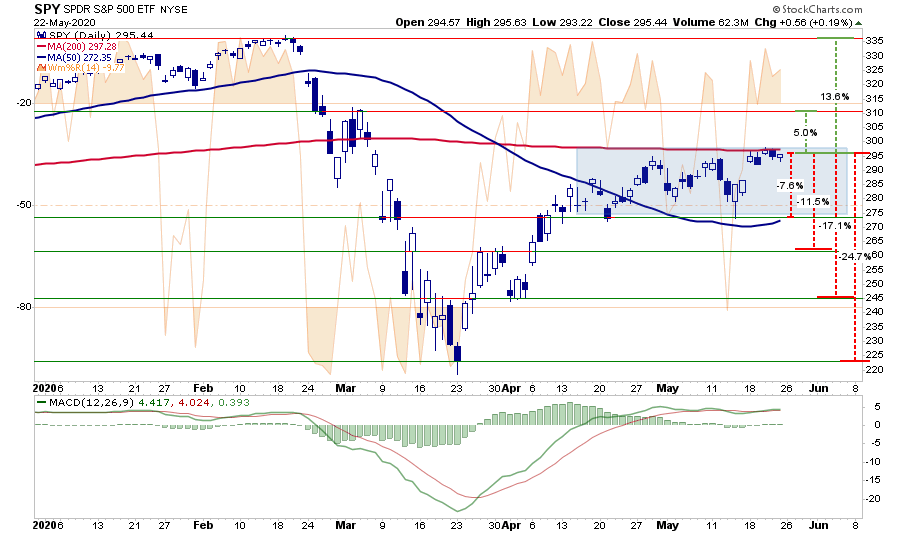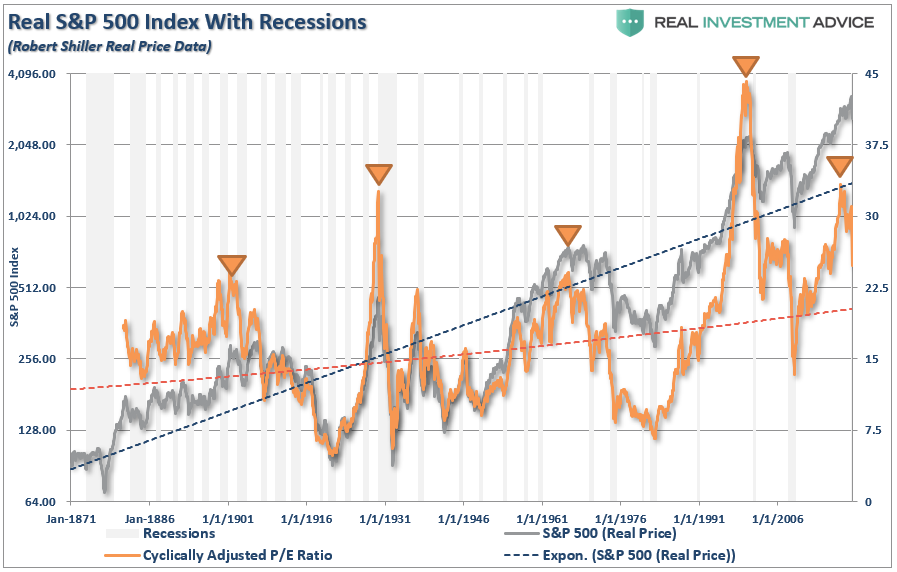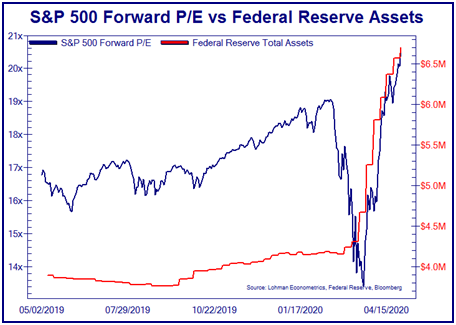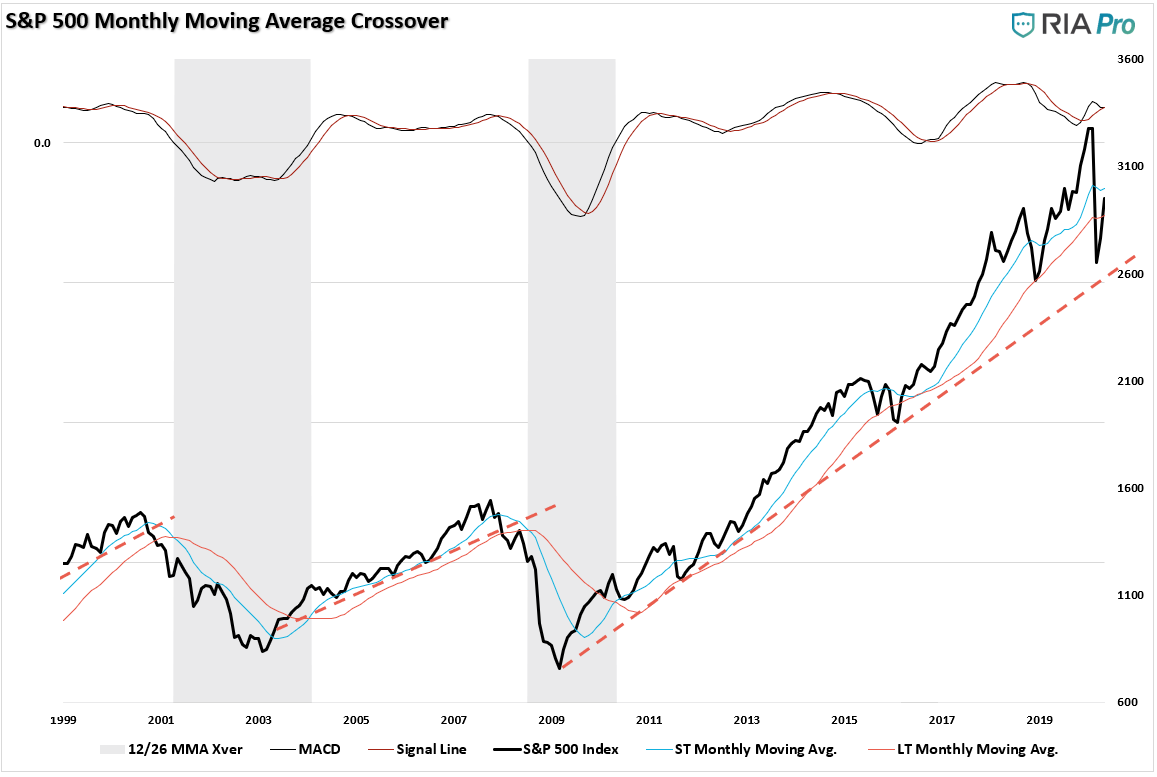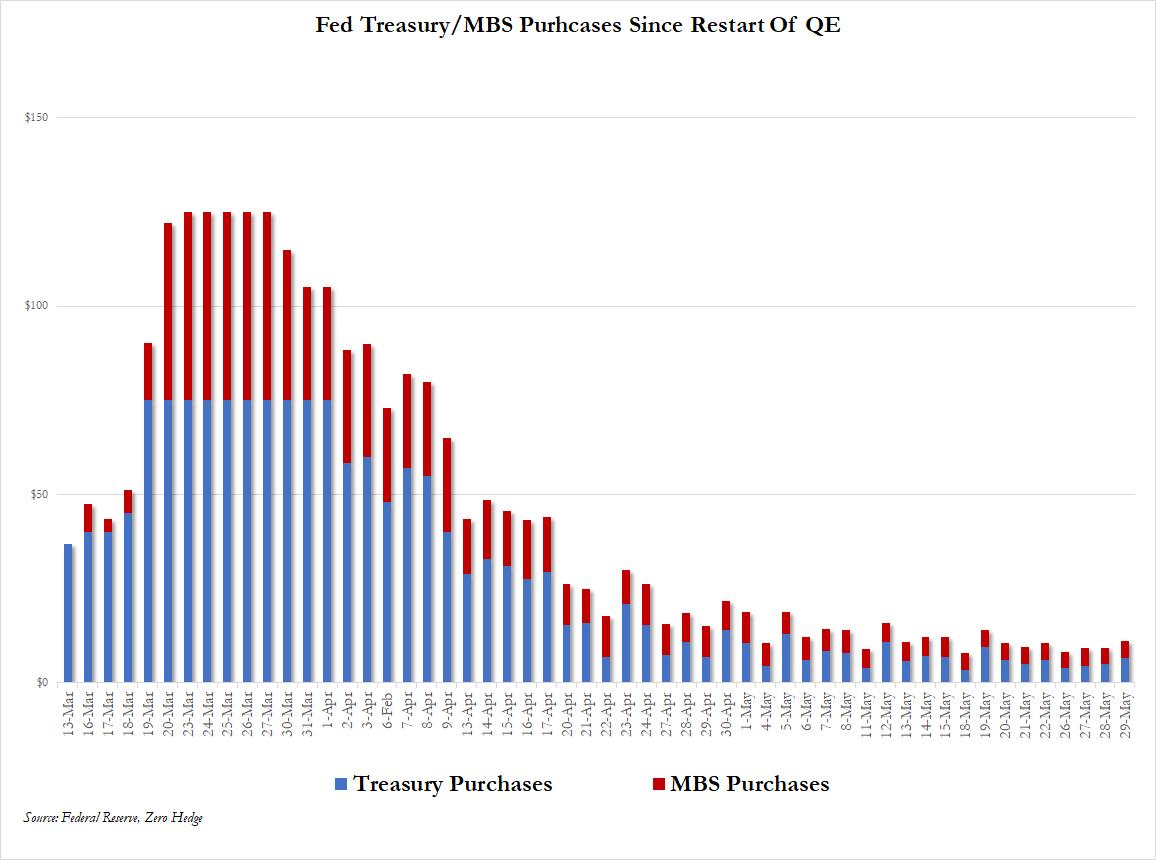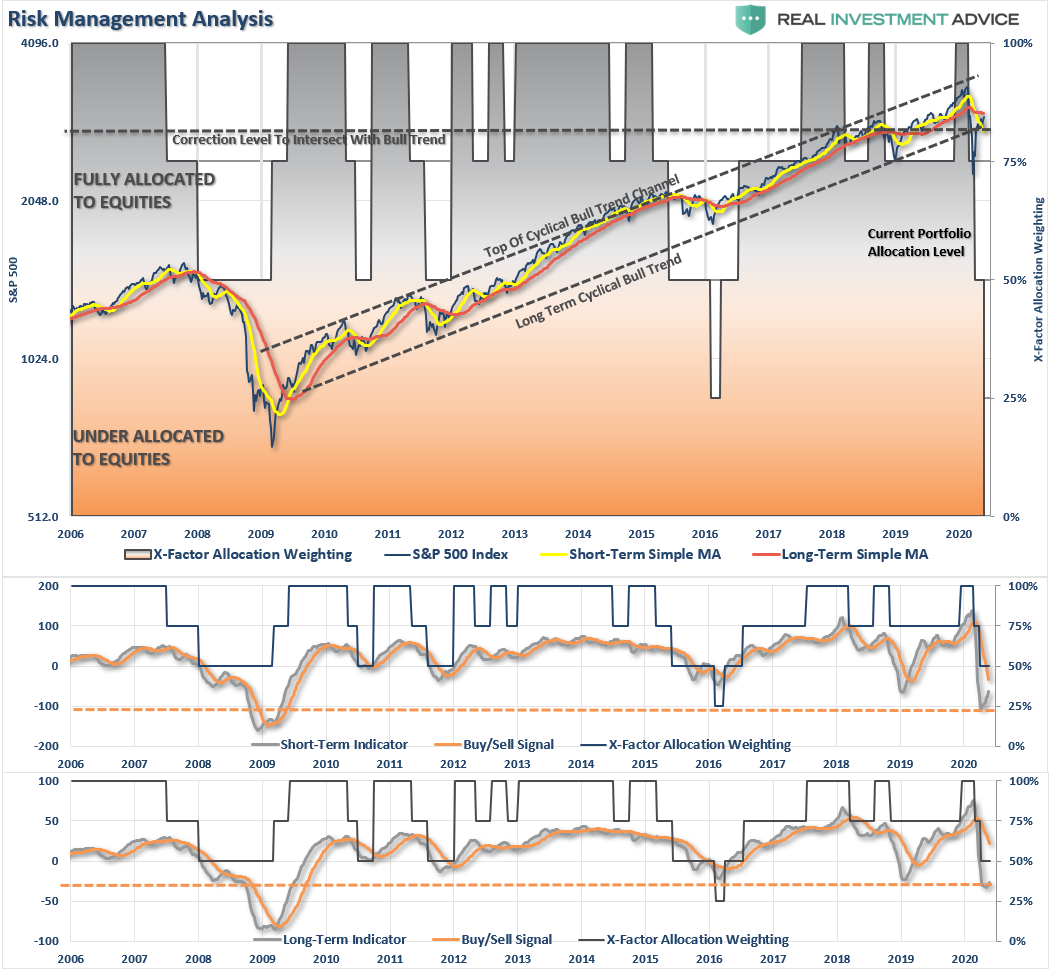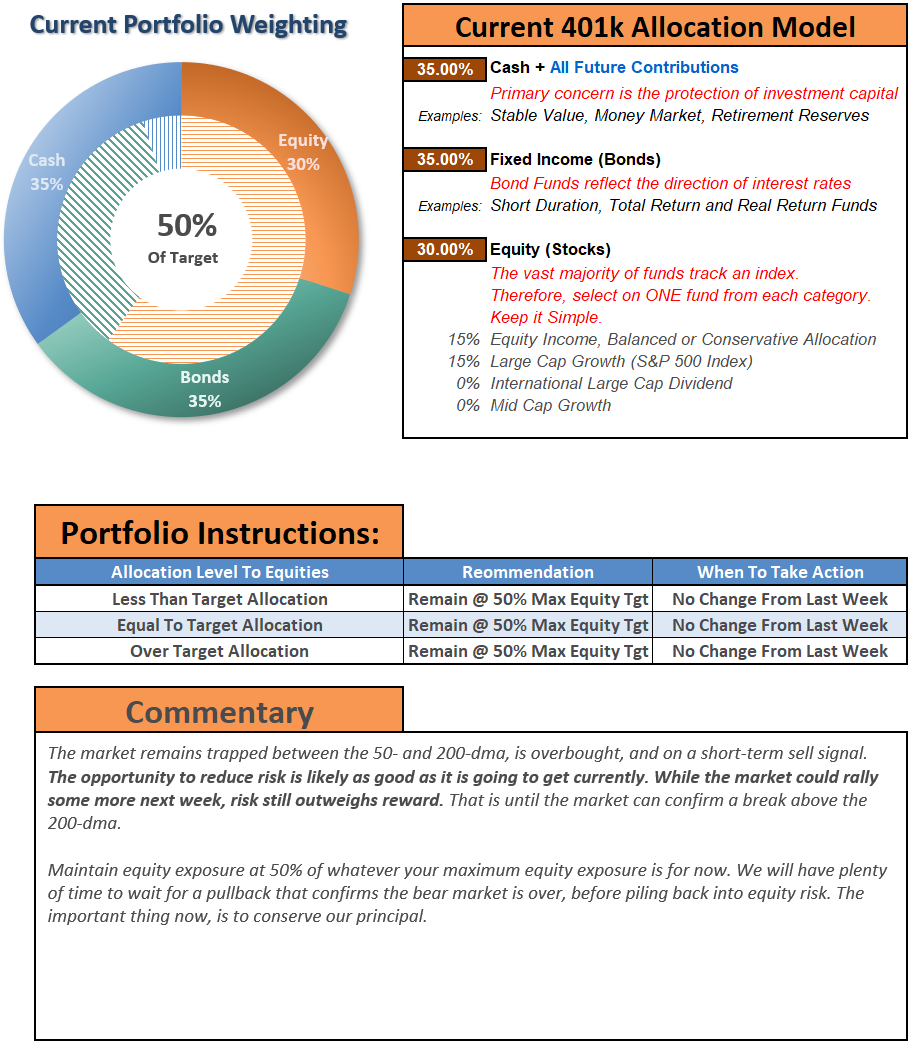Bear Market? Or Just A Big Correction? 05-22-20
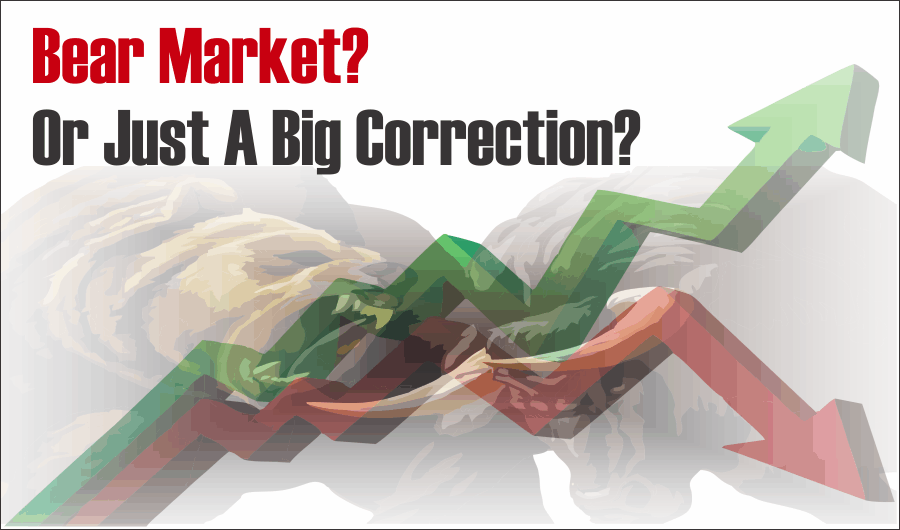
In this issue of “Was This A Bear Market? Or Just A Big Correction?”
- Still Stuck In The Middle
- What Defines A “Real” Bear Market?
- A Growing List Of Concerns
- Portfolio Positioning
- MacroView: Why Jeremy Siegel Is Wrong About Bonds
- Sector & Market Analysis
- 401k Plan Manager
Follow Us On: Twitter, Facebook, Linked-In, Sound Cloud, Seeking Alpha
Catch Up On What You Missed Last Week
Still Stuck In The Middle
As noted last week, the markets remain stuck between the 50- and 200-dma. That remained the case this week once again, keeping any expansion of equity positioning on hold.
The shaded blue area shows the containment of the market between the two moving averages. With the market very overbought short-term (orange indicator in the background), there is downside pressure on prices short-term.
This past week, the current risk/reward ranges remain unfavorable. I have updated the levels from last week:
- -7.6% to the 50-dma vs. +5% to the March peak.
- -11.5% to -17.1% to the late March peak or early April low vs. +13.6% to all-time highs.
- -24.7% to March 23rd lows vs. 13.6% to all-time highs.
For now, we remain “stuck in the middle.”
However, if the markets can break above the 200-dma, and maintain that level, it would suggest the bull market is back in play. Such would change the focus from a retest of previous support to a push back to all-time highs.
While such would be hard to believe, given the economic devastation currently at hand, technically, it would suggest the decline in March was only a “correction” and not the beginning of a “bear market.”
Was This A Correction Or A Bear Market?
Price is nothing more than a reflection of the “psychology” of market participants. A potential mistake in evaluating “bull” or “bear” markets is using a “20% advance or decline” to distinguish between them.
Such brings up an interesting question. After a decade-long bull market, which stretched prices to extremes above long-term trends, is the 20% measure still valid?
To answer that question, let’s clarify the premise.
- A bull market is when the price of the market is trending higher over a long-term period.
- A bear market is when the previous advance breaks, and prices begin to trend lower.
The chart below provides a visual of the distinction. When you look at price “trends,” the difference becomes both apparent and useful.
This distinction is important.
- “Corrections” generally occur over very short time frames, do not break the prevailing trend in prices, and are quickly resolved by markets reversing to new highs.
- “Bear Markets” tend to be long-term affairs where prices grind sideways or lower over several months as valuations are reverted.
Using monthly closing data, the “correction” in March was unusually swift but did not break the long-term bullish trend. Such suggests the bull market that began in 2009 is still intact as long as the monthly trend line holds.
However, I have noted the market may be in the process of a topping pattern. The 2018 and 2020 peaks are currently forming the “left shoulder” and “head” of the topping process. Such would also suggest the “neckline” is the running bull trend from the 2009 lows. A market peak without setting a new high that violates the bull trend line would define a “bear market.”
Valuations
Valuations also suggest the decline in March was just a correction and not a bear market.
The chart below shows the history of secular bull market periods going back to 1871 using data from Dr. Robert Shiller. The defining difference between bull and bear markets is valuations. Bull markets are defined by expanding valuations, while bear markets contract valuations. Market “corrections” tend to have minimal impacts on valuations.
During trending bull markets, valuations remain elevated even during corrective processes. However, during bear markets, valuations tend to compress as prices adjust to weaker earnings growth.
The surge in valuations in recent weeks suggests the markets remain in a “corrective” process rather than a “bear market.”
While monetary policy has kept the valuation reversion process from completing, it likely hasn’t eliminated the risk.
If March was indeed just a “correction,” then earnings will need to quickly recover back to previous levels to support current valuation levels. However, given the economic devastation, I suspect the “correction” was likely the beginning of a more protracted valuation reversion process and “bear market.”
Monthly Moving Average Crossover
Lastly, from a purely technical perspective, we have not confirmed a “traditional” bear market. One of the key identifiers of a “bear market” versus a “correction” is the “bearish crossover” of the short and long-term moving averages.
In both 2001 and 2008, the moving average crossover delineated the start of a more protected “bear market” process. Despite the one month correction in March, the rebound in April and May have kept the moving average crossover from triggering.
Without a monthly moving average crossover, there is little historical precedent to suggest the decline in March was anything other than a deep corrective process.
However, if we are in the beginning stages of a longer-term valuation reversion process, then the crossover will occur in the months ahead.
Bear Markets Begin With Corrections
There is one crucial point that needs addressing.
Was the decline in March just a “correction” or the start of a “bear market?”
Only time will tell with certainty, but all “bear markets” begin with a “correction.”
Every bear market in history has an initial decline, a reflexive rally, then a protracted decline which reverts market excesses. Investors never know where they are in the process until the rally’s completion from the initial fall.
Given the deviation of the market, due to Fed stimulus, was so extremely deviated above long-term trends, the depth of the “correction” was not surprising. However, if this is the start of a “bear market,” confirmed by a change in trend, the depth of the decline will eventually be equally as great.
A Growing List Of Concerns
What we do know is there is a litany of warning signs which suggest risk greatly outweighs the reward of being aggressively invested in the markets. Here is a shortlist:
- Frantic positioning and extreme readings in market internals.
- Speculative positioning in options markets.
- Small investors are incredibly bullish.
- Put/Call ratios are massively elevated.
- A lack of risk hedging.
- Buying interest has hit extremes.
- Forward P/E ratios are historically rich.
- Value to Growth ratios are at some of the lowest levels in history.
- The hope for a “V-shaped” recovery is likely to be disappointed.
- Expectations for an earnings recovery remain overly exuberant.
- Unemployment is likely to remain elevated longer than most expect.
- Consumer confidence will likely not bounce back as fast as hoped.
- Rising delinquencies, defaults, and bankruptcies will be problematic.
- A resurgence of COVID-19 later this summer will set back recovery expectations.
- Fed liquidity is likely much more limited than markets expect.
- A resurgence of a “trade war” with China could not be more ill-timed.
- Risk of acceleration of geopolitical tensions with China
- Corporate profitability will plunge
I could go on, but you get the idea.
Don’t Fight The Fed
With the amount of economic devastation that is in process, and will likely continue for quite some time, it is hard to suggest the decline in March was only a “correction.” There are numerous headwinds that could derail markets in the months ahead despite the Fed’s liquidity.
Speaking of liquidity, the basis of the “Don’t Fight The Fed” mantra, has now shrunk from $75 billion/day in March to just $5 billion/day.
The most logical view is that we are in the midst of a torrid reflexive rally that seems to be losing steam. Such would be typical of a reflexive “bear market rally.,” Over the next couple of months the markets will have to come to grips with economic and fundamental realities.
The next leg lower will likely surprise most investors.
Positioning Update
This analysis is part of our thought process as we continue to weigh “equity risk” within our portfolios.
We remain focused on our positioning, and we again modestly increased our equity exposure during this past week. However, we also balanced that increase with matched weights in Treasury bonds to hedge our risk.
Taking profits in our trading positions also continues to be a “staple” in our management process. This past week we took profits in the Communications space that has gotten extremely extended. We also continue to rebalance portfolios regularly.
We don’t like the risk/reward of the market currently, and suspect we will have a better opportunity to increase equity risk later this summer. But, if things change, we will also.
What is essential is remembering one investing truth. Investing isn’t a competition of who gets to say “I bought the bottom.” Investing is about putting capital to work when reward outweighs the risk.
That is not today.
Bear markets have a way of “suckering” investors back into the market to inflict the most pain possible.
Such is why “bear markets” never end with optimism but in despair.

The MacroView
If you need help or have questions, we are always glad to help. Just email me.
See You Next Week
By Lance Roberts, CIO
Market & Sector Analysis
Data Analysis Of The Market & Sectors For Traders
MISSING THE REST OF THE NEWSLETTER?
This is what our RIAPRO.NET subscribers are reading right now! Risk-Free For 30-Day Trial.
- Sector & Market Analysis
- Technical Gauges
- Sector Rotation Analysis
- Portfolio Positioning
- Sector & Market Recommendations
- Client Portfolio Updates
- Live 401k Plan Manager
THE REAL 401k PLAN MANAGER
A Conservative Strategy For Long-Term Investors
If you need help after reading the alert; do not hesitate to contact me
Model performance is a two-asset model of stocks and bonds relative to the weighting changes made each week in the newsletter. Such is strictly for informational and educational purposes only and should not be relied on for any reason. Past performance is not a guarantee of future results. Use at your own risk and peril.
401k Plan Manager Live Model
As an RIA PRO subscriber (You get your first 30-days free) you have access to our live 401k plan manager.
Compare your current 401k allocation, to our recommendation for your company-specific plan as well as our on 401k model allocation.
You can also track performance, estimate future values based on your savings and expected returns, and dig down into your sector and market allocations.
If you would like to offer our service to your employees at a deeply discounted corporate rate, please contact me.







